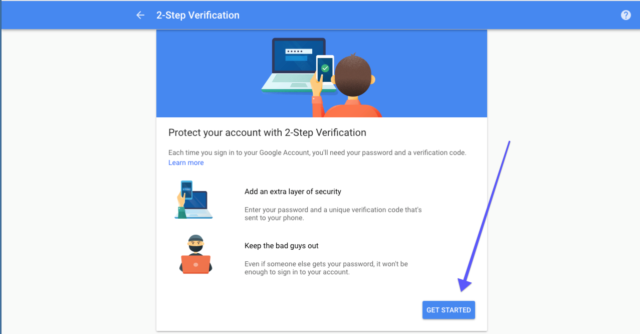What is multi-factor authentication? How does it work?
It is an authentication feature which allows the user to access a particular application, account or website only after providing two or more verification evidences. In simple terms, it is a way to ensure that the person trying to log into an account is actually the owner of that account. Apart from the username and password, the multi-factor authentication mechanism asks for additional identity factors which only the user is aware of. These include:
Inherence Factor – Inherence factors are the ones that the user was born with and include face recognition, fingerprints, iris imprint, etc. These are the most unique and reliable authentication factors, but also the most difficult to manage.Knowledge Factor–This factor is the one that only the user is aware of such as passwords, security PIN, personal facts such as birth date,etc.The user has it stored in their memory and enters it manually when asked for. Knowledge factors are usually used for verification using single-factor authentication.Possession Factor–This factor includes something that the user is in possession of such as a smartphone or a security key. Authentication via possession factors may involve sending a One Time Password (OTP) to the registered smartphone, entering the CVV code given on a debit or credit card, etc.Location Factor– It involves setting the user’s location to an account and verifying the same using GPS.In the case of any discrepancy, access to the account is not granted. It is advisable to use this factor with a host of other more secure factors for better protection.
Advantages and disadvantages of multi-factor authentication
Multi-factor authentication, often referred to as two-factor authentication, is an important electronic authentication tool that is being used almost everywhere today.So, what makes multi-factor authentication popular? Check Out – Zoom Introduces Two-Factor Authentication – 2FA As the name suggests, two-factor authentication simply uses two layers of verification – the password and the authorization evidence.On the other hand, multi-factor authentication uses more than two verification layers.
Advantages of multi-factor authentication
Adds a layer of security to the password
Passwords alone are not reliable to protect accounts especially those that are linked to a variety of other vital accounts.Most of the passwords used by users are not strong or unique enough to provide ultimate protection. Moreover, there can be breach on any third-party site where the account is used. Multi-factor authentication ensures that if the login credentials get compromised, the password will not be enough to break into the account. Thus, by adding an extra layer of authentication, cybersecurity can be enhanced to a great extent. You Might Also Like –Malware Threat: Different Types of Malware Attacks
Safeguards confidential information
Sometimes, users can be reckless and vulnerable to falling prey to hacking attempts. An organization, in particular, can be at high risk if its employees do not follow the best online security protocols. Incorporating multi-factor authentication can protect the user or the organization by providing the first line of defence. Although 100% security is not guaranteed, it is capable of thwarting attacks trying to steal passwords, thus safeguarding confidential information.
Meets regulatory requirements
Certain industries have made it compulsory for organizations to add password security. This is to ensure that only authorized persons are able to access the data. Multi-factor authentication is implemented to meet these compliance requirements. On one hand, it saves the organization from penalties arising out of breach of rules, on the other, it protects the organization’s hardware and software systems from intrusion.
Helps in setting up a Single Sign-On solution
Creating separate complex passwords for every account or application can be inconvenient. One of the biggest advantages of multi-factor authentication is that it helps in establishing consumer identity, which can be utilized for devising SSO solutions. An SSO solution streamlines the sign-in process across accounts, thus saving time and effort. It creates a set of credentials that can be used to sign into multiple accounts at once.Therefore, it provides security and convenience as the user need not follow separate authorization procedures for every account.
Keeps information in lost devices secure
A lost device can be a cause for concern especially if it contains access to your bank account or other high-value data. Someone may try to get access to that information by hacking into your phone’s screen lock. Multi-factor authentication that involves a set of authorization factors can prevent loss of data from a misplaced device. However, this might be a failure if only a possession factor is used for verification because then the SMS code will be sent on the device itself. For complete security, this may have to be complimented with full-disk encryption.
Disadvantages of multi-factor authentication
Despite the numerous benefits, multi-factor authentication can be a hassle for many users. It has its own share of disadvantages, most of which lie in its implementation.
Locks the user out of the application or the account
If the user is unable to access the verification factor other than the password, then they can be locked out of their account. There should always be a reliable backup in place or an alternate way to gain access to the concerned account.
Cumbersome task
Some users may find the task of using an additional source of authorization to be time consuming. They may, thus, be reluctant in activating the same on their account. Users can remember devices linked to their account so that they don’t have to use multi-factor authentication every time they log in.
Relies on third parties
Multi-factor authentication requires integration of various services such as SMS for sending verification codes. Users have no control over these third-party services, depriving them of the ability to access these mechanisms should anything faulter.
Not fully secure
Although this method of authentication is better than single factor security protocols, it is still not 100% reliant. Using multiple evidences can provide better protection, but it ends up complicating the sign-in process. Nevertheless, it is not impossible to break into multi-factor authentication mechanism.






